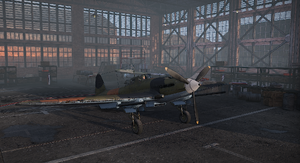
The Ilyushin Il-2 (Cyrillic: Илью́шин Ил-2) Shturmovik (Cyrillic: Штурмови́к, Shturmovík) was the most important war plane of the Soviet Union in World War II.
Background[ | ]
The ultimate incarnation of the armored ground attack plane idea born in the 1930s in the Soviet Union, the Il-2 was designed by Sergey Ilyushin in 1938. Designed from the ground up as an armored assault aircraft, the plane was designed with an armored shell weighing in excess of 700 kg, protecting the crew, engine, radiatiors, and the fuel tank. To save weight, the armor doubled as a loadbearing structure.
The Il-2's design, as a single-engine propeller-driven monoplane with heavy armor and heavy armament prevailed against competing designs from Sukhoi and was pressed into production after being upgraded with a more powerful powerful plant, the Mikulin AM-38, and finally passing trials in April 1941. Its firepower, resilience, and reasonable price tag made it a vital part of the Soviet war effort - so much that Stalin described the Il-2 as being as important to the Red Army as air or bread.
It remained in production until 1945, with 36 183 units produced, and the last units were retired as late as 1954 by Yugoslavia and Bulgaria. Together with its successor, the Il-10, it became the most produced military aircraft in history.
Models[ | ]
Il-2KR[ | ]

Il-2KR (korrektirovschchik, spotter) was intended as a battlefield spotting and reconnaissance aircraft and had a more powerful radio and a camera. The radio was an RSI-3bis, with the AFA-1 or AFA-1M camera in the rear fuselage. It carried a lighter weapon load: The Volkov-Yartsev VYa-23 23mm autocannon, the ShKAS (Shpitalny-Komaritski Aviatsionny Skorostrelny, Shpitalny-Komaritski rapid fire for aircraft) 7.62mm machine gun, and the Berezin UB (УБ - Универсальный Березина, Berezin's Universal) in a turret configuration, that could be replaced with an additional camera.
It's used as:
Il-2M[ | ]

The 1943 Il-2 production run, referred to in the West as the Il-2M, was powered by an upgraded AM-38F aircraft engine giving 1,310 kW (1,750 HP), added a rear gunner with the Berezin UB turret to provide more protection from fighters, and minor improvements to aerodynamics and protection. It also represented a standardization, with all Il-2s armed with 20mm autocannons retired or converted to 23mm autocannons. As such, the total armament included the Volkov-Yartsev VYa-23 23mm autocannon, the ShKAS (Shpitalny-Komaritski Aviatsionny Skorostrelny, Shpitalny-Komaritski rapid fire for aircraft) in 7.62mm that originally served as basis for the ShVAK 20mm autocannon, and the Berezin UB (УБ - Универсальный Березина, Berezin's Universal) 12.7mm heavy machine gun in the UBT configuration (Турельный, Turelniy, for the turret).
Variants[ | ]
- Standard
- Cluster bombers
- Il-2M AP Cluster Bomber (Pol): PTAB (Противотанковая Авиабомба, Antitank Aviation Bomb) was a small 2.5kg bomb filled with 1.5kg of explosives, designed to be deployed in clusters from cassettes. The Il-2 carried 280 PTABs in its bomb bay folds or 192 in four cassettes. With the ability to penetrate up to 70mm of armor, the PTAB was capable of destroying most tanks on the battlefield as long as it struck their top.
- Il-2M HE Cluster Bomber: The AO-10 was a 10 kg cluster munition designed for deployment against enemy soft targets, deployed from casettes.
- General purpose bombers
FAB (фугасная авиационная бомба, fugasnaya aviatsionnaya bomba, aerial bomb) is a general purpose high explosive aviation bomb, featuring airfoil stabilization, nose and backup tail fuse, and a variable amount of high explosives. The bomb's nominal weight follows the acronym and indicates explosive power, from the modest 50kg bombs to the exceptionally powerful 500kg or half-ton bombs.
- Rockets
Rocket-armed Soviet warplanes use various types of the RS-82 (реактивный снаряд, rocket projectile) family first developed in the early 1930s by a team under the leadership of Georgy Langemak. Entering service in 1937 (82mm variants) and 1938 (132mm variants), the unguided rockets suffered from low accuracy, with just a 1.1% chance of hitting the target directly when fired from aircraft. As such, they were fired in salvos to saturate the area and suppress targets. Armor piercing high explosive variants were available, designated RBS (реактивный Бронебойный снаряд, anti-tank rocket projectile), but they, too, suffered from the same limitations.
- Il-2M Light Rocket 82mm
- Il-2M AT Rocket 82mm: 82mm rockets with an APHE warhead.
- Il-2M Medium Rocket 132mm
- Il-2M AT Rocket 132mm: 132mm rockets with an APHE warhead.
Il-2M3[ | ]

The Il-2M3 was an upgraded IL-2M, with an added rear gunner operating a 12.7mm Berezin UBT (Универсальный Березина Турельный, Berezin Universal for Turrets) machine gun and increased armor, to a total of 950 kg (2 100 lbs). Wings were modified by adding a swept-back outer wing platform and a straight trailing edge, together with all-metal wing panels, to adjust the center of gravity changed by the addition of the gunner. It carried the same armaments as previous Shturmowiks: VYa-23 23mm autocannon, ShKAS 7.62mm machine gun, and the aforementioned Berezin UBT.
Variants[ | ]
- Rockets
- Il-2M3 Light Rocket: 82mm rockets.
- Il-2M3 AT Rocket (Pol): RBS variant.
- Bombers
Il-2-37[ | ]

The Il-2-37 was a variant of the Il-2M outfitted with two Nudelman-Suranov NS-37 37mm autocannons in conformal gun pods under the wings, similar to the Junkers Ju 87 Kanonenvogel variants. However, the performance was far cry from that of the German dive bomber, and the reduced bomb load (a third of the regular Il-2's 600kg capacity) resulted in the variant being cancelled after just 3 500 units were produced. The PTAB-armed Il-2s became the main anti-tank weapon on the front. Apart from the NS-37, also used on the LaGG-3 and Yak-9T fighters, it also carried the ShKAS 7.62mm machine gun and the turret-mounted Berezin UB (УБ - Универсальный Березина, Berezin's Universal).
Variants[ | ]
- Il-2-37 Tank Buster: The basic variant.
- Il-2-37 Light Bomber (50 kg) (100 kg)
